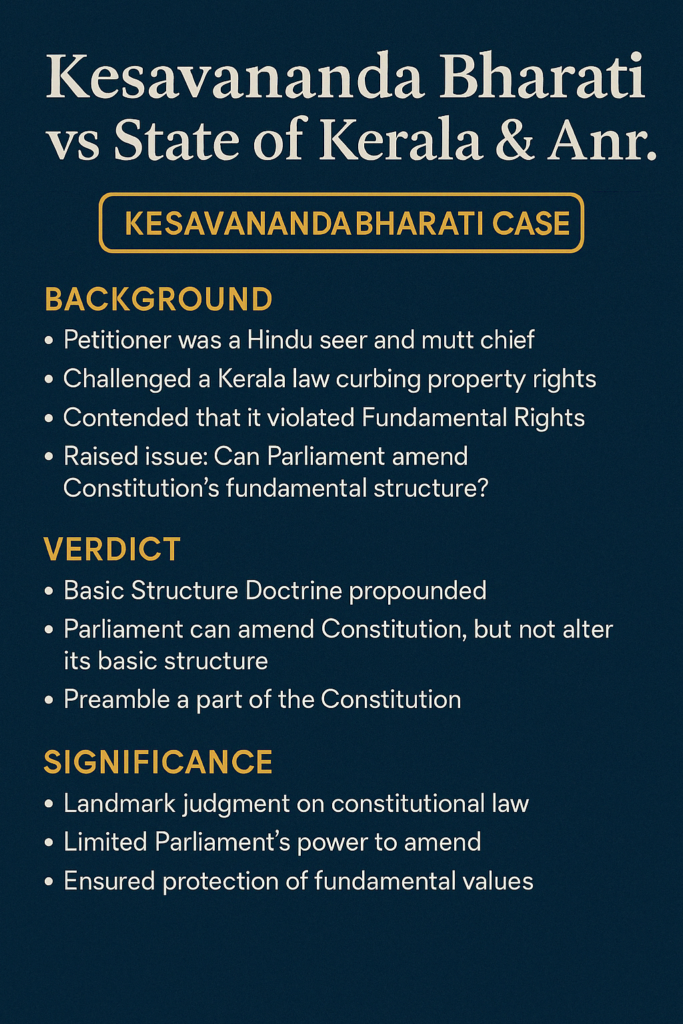
Case Name: Kesavananda Bharati v. State of Kerala & Anr.
Citation: AIR 1973 SC 1461
Date of Judgment: April 24, 1973
Bench: 13 Judges (largest ever in Indian history)
Verdict: 7:6 Majority
🕰️ Background:
During the case, Parliament passed the 24th, 25th, and 29th Amendments—giving itself more power to amend the Constitution and protect land reforms.
Petitioner: Swami Kesavananda Bharati, head of Edneer Mutt in Kerala.
Challenged the Kerala Land Reforms Act, 1969, which imposed land ceilings and allowed the government to take over certain lands.
Filed a writ petition under Article 26 (religious freedom) and Article 31 (Right to property).
🔑 Legal Issues:
Is there any “Basic Structure” to the Constitution that cannot be altered?
Does Parliament have unlimited power to amend the Constitution under Article 368?
Can Parliament amend or destroy Fundamental Rights?
⚖️ Arguments by the Petitioner:
Amendments that abrogate rights or change the democratic/republican nature are unconstitutional.
Fundamental Rights are part of the basic essence of the Constitution.
Parliament is a creature of the Constitution, hence cannot destroy its foundation.
🧩 Constitutional Provisions Involved:
- Article 368 – Power and procedure of Constitutional amendments
- Article 13(2) – Laws inconsistent with Fundamental Rights are void
- Preamble – Reflects the spirit of the Constitution
- Fundamental Rights – Article 14 (Equality), 19 (Freedom), 21 (Life), 31 (Property, repealed)
⚖️ Arguments by the State:
Judiciary should not interfere in legislative domain.
Parliament has plenary sovereign power to amend any part of the Constitution.
Article 368 grants the power and procedure for amendment.
Without this power, Parliament cannot implement socio-economic reforms.
🧠 Key Legal Questions:
- Does Article 368 give unlimited power to Parliament to amend the Constitution?
- Can Parliament abrogate Fundamental Rights via amendments?
- Is the Preamble part of the Constitution and amendable?
- Can Parliament change the “basic structure” of the Constitution?
🧾 The Verdict:
🔹 Majority (7 Judges):
- Parliament has wide powers to amend the Constitution under Article 368.
- BUT it cannot alter or destroy the “Basic Structure” of the Constitution.
- Some parts of the Constitution are immutable, even by constitutional amendment.
🔹 Minority (6 Judges):
- Parliament has complete sovereignty to amend any provision, including Fundamental Rights.
- There should be no limitation on amending power if proper procedure is followed.
🧱 Basic Structure Doctrine (Key Takeaway)
The Basic Structure Doctrine says that certain fundamental features of the Constitution cannot be amended, even by Parliament.
🧩 Elements of the Basic Structure (non-exhaustive):
Fundamental Rights
Supremacy of the Constitution
Sovereign, democratic, and republican nature
Secularism
Separation of powers
Federalism
Judicial review
Free and fair elections
Rule of law
✍️ Key Contributions by Judges:
- Justice H.R. Khanna: His swing vote was decisive in the 7–6 split.
- Justice Sikri (CJI): Led the majority and emphasized constitutional supremacy.
- Justice Y.V. Chandrachud: Part of the minority; later became CJI.
🔄 Doctrinal Shift from Previous Cases:
| Case | Position |
|---|---|
| Shankari Prasad (1951) | Parliament can amend Fundamental Rights |
| Sajjan Singh (1965) | Reaffirmed Shankari Prasad |
| Golaknath (1967) | Parliament cannot amend Fundamental Rights |
| Kesavananda (1973) | Parliament can amend, but not alter Basic Structure |
🔥 Significance of the Judgment:
Changed India’s constitutional history: All future constitutional amendments are tested against the Basic Structure Doctrine.
Preserved democratic values: Set limits on parliamentary power.
Strengthened judicial review: Courts became guardians of constitutional integrity.
Introduced flexibility with caution: Allowed amendments without destroying core principles.
📜 Impact:
42nd Amendment (1976) attempted to override this doctrine, declaring that no constitutional amendment could be questioned in court.
Government was unhappy; PM Indira Gandhi criticized the judgment
Led to the controversial Emergency (1975–77) and 42nd Amendment, which tried to override the judgment—but it was later nullified in Minerva Mills (1980).
🏛️ Legacy:
Seen as the “Guardian Judgment” that saved Indian democracy.
Still holds the field today — every amendment is scrutinized under this doctrine.
India’s Constitution is flexible, but not fragile.
